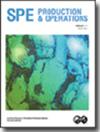Acid Tunneling in Carbonate Rocks: A Full-Scale Experimental Study
IF 1.3
4区 工程技术
Q2 ENGINEERING, PETROLEUM
引用次数: 1
Abstract
Acid tunneling is an acid-jetting method for stimulating carbonate reservoirs. Several case histories from around the world were presented in the past showing optimistic post-stimulation production increases in openhole wells compared with conventional coiled-tubing (CT) acid jetting, matrix acidizing, and acid fracturing. However, many questions about the actual tunnel creation and tunneling efficiency are still not answered. In this paper, the results of an innovative full-scale research program involving water and acid jetting are reported for the first time. The tunnels are constructed through chemical reaction and mechanical erosion by pumping hydrochloric acid (HCl) through conventional CT and a bottomhole assembly (BHA) with jetting nozzles and two pressure-activated bending joints that control the tunnel-initiation directions. If the jetting speed is too high and the acid is not consumed in front of the BHA during the main tunneling process, then unspent acid flows toward the back of the BHA and creates main wellbore and tunnel enlargement with potential wormholes as fluid leaks off, lowering the tunneling-length efficiency. Full-scale water- and acid-jetting tests were performed on Indiana limestone cores with 2- to 4-md permeability and 12 to 14% porosity, sourced from the same supplier. Many field-realistic combinations of nozzle sizes, jetting speeds, and casing pressures were included in the testing program. The cores were 3.75 in. in diameter × 6 in. in length for the water tests and 12 in. in diameter × 18 in. in length for the tests with 15-wt% HCl acid. The jetting BHA was moved as the tunnels were constructed, at constant force on the nozzle mole, to minimize the nozzle standoff. Six acid tests were performed at the ambient temperature of 46°F and two at 97°F. The results from the acid tests show that the acid-tunneling efficiency, defined as the tunnel length divided by the acid volume, can be optimized by reducing the nozzle size and pump rate. The results from the water and acid tests with exactly the same parameters to match the actual CT operations in the field show that the tunnels are constructed mostly by chemical reaction and not by mechanical erosion. The acid-tunneling efficiencies obtained from the full-scale acid tests are superior to the average tunneling efficiency of more than 500 actual tunnels constructed during more than 100 acid-tunneling operations performed to date worldwide. Although the tunnel lengths and acid volumes for the actual tunnels constructed during the previous acid-tunneling operations were recorded by the service company performing those operations, little downhole temperature and formation characterization data were provided by the operators to the service company. Thus, the downhole-temperature and formation-characterization effects on the acid-tunneling efficiency for the previous field operations are unknown. In this paper, we describe the full-scale water- and acid-jetting tests on Indiana limestone cores. The major novelty of this test program consists of performing all measurements with casing pressure, unlike all previous water- and acid-jetting studies performed at atmospheric conditions and reported in the literature, which is closer to the field conditions during CT operations. The novel understanding of the combined effect of the nozzle size, pump rate, and casing pressure significantly improves the actual acid-tunneling efficiency.碳酸盐岩酸性隧道:全尺寸实验研究
酸隧道是一种酸喷射方法,用于刺激碳酸盐岩储层。过去,世界各地的一些案例表明,与传统连续油管(CT)酸喷射、基质酸化和酸压裂相比,裸眼井增产效果良好。然而,关于实际隧道创建和隧道效率的许多问题仍然没有得到回答。本文首次报道了一项涉及水和酸喷射的创新性全面研究计划的结果。隧道是通过化学反应和机械侵蚀建造的,通过泵送盐酸(HCl)通过传统的CT和底部钻具组合(BHA),底部钻具组合带有喷嘴和两个压力激活的弯曲接头,控制隧道启动方向。如果喷射速度太高,并且在主掘进过程中,酸没有在BHA前面消耗掉,那么未使用的酸会流向BHA的后面,并在流体泄漏时产生主井筒和隧道扩大,可能会产生虫洞,从而降低掘进长度效率。对来自同一供应商的渗透率为2-4天、孔隙度为12-14%的印第安纳石灰岩岩芯进行了全尺寸水和酸喷射试验。测试程序中包括喷嘴尺寸、喷射速度和套管压力的许多现场实际组合。岩心直径3.75英寸 × 水压试验长度为6英寸,直径为12英寸 × 长度为18英寸,用于用15wt%盐酸进行的测试。在隧道施工过程中,在喷嘴摩尔上施加恒定力的情况下,移动喷射BHA,以最大限度地减少喷嘴间距。在46°F的环境温度下进行了六次酸性试验,在97°F的温度下进行两次。酸测试的结果表明,酸隧道效率(定义为隧道长度除以酸体积)可以通过减小喷嘴尺寸和泵速来优化。与现场实际CT操作完全匹配的水和酸测试结果表明,隧道主要通过化学反应而非机械侵蚀建造。从全尺寸酸蚀试验中获得的酸蚀隧道效率优于迄今为止在全球进行的100多次酸蚀隧道作业中建造的500多个实际隧道的平均隧道效率。尽管在之前的酸液隧道作业期间建造的实际隧道的隧道长度和酸液体积是由执行这些作业的服务公司记录的,但操作员向服务公司提供的井下温度和地层特征数据很少。因此,井下温度和地层特征对先前现场作业的酸隧道效率的影响是未知的。在本文中,我们描述了印第安纳石灰岩岩芯的全尺寸水和酸喷射试验。该测试程序的主要新颖之处在于在套管压力下进行所有测量,这与文献中报道的在大气条件下进行的所有水和酸喷射研究不同,后者更接近CT操作期间的现场条件。对喷嘴尺寸、泵速和套管压力的综合影响的新理解显著提高了实际的酸隧道效率。
本文章由计算机程序翻译,如有差异,请以英文原文为准。
求助全文
约1分钟内获得全文
求助全文
来源期刊

Spe Production & Operations
工程技术-工程:石油
CiteScore
3.70
自引率
8.30%
发文量
54
审稿时长
3 months
期刊介绍:
SPE Production & Operations includes papers on production operations, artificial lift, downhole equipment, formation damage control, multiphase flow, workovers, stimulation, facility design and operations, water treatment, project management, construction methods and equipment, and related PFC systems and emerging technologies.
 求助内容:
求助内容: 应助结果提醒方式:
应助结果提醒方式:


